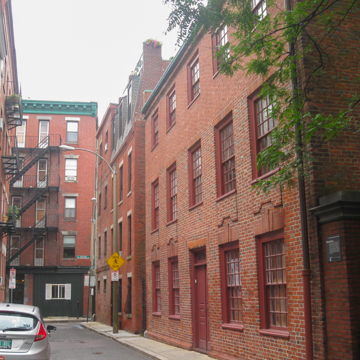One of a handful of extant brick dwellings built just after the 1711 fire, 21 Unity Street helped introduce English vernacular urban forms that transformed Boston into a brick provincial city. The product of an artisan subdivision of Bennet's pasture after 1703, most of the lots and brick houses were sold within a few years by brick mason Ebenezer Clough or his widow. Clough and housewright John Barret built two-and-a-half-story brick investment properties separated by a party wall. Although Barret's half house is gone, it shared with Clough's a Flemish bond facade, a rubbed and shaped brick door lintel, and projecting brick aprons below the second-story windows. A hooded door head originally surmounted the double front door. Adding a third floor in the early nineteenth century eliminated a gambrel roof and paneled chimneys, and the present sash windows replaced mullioned casements. Clough also worked as a bricklayer on the adjacent Christ Church.
You are here
Ebenezer Clough House
1711–1715, Ebenezer Clough, brick mason; John Barret housewright?; early 1800s enlarged; 1960–1964 restored, Charles R. Strickland. 21 Unity St.
If SAH Archipedia has been useful to you, please consider supporting it.
SAH Archipedia tells the story of the United States through its buildings, landscapes, and cities. This freely available resource empowers the public with authoritative knowledge that deepens their understanding and appreciation of the built environment. But the Society of Architectural Historians, which created SAH Archipedia with University of Virginia Press, needs your support to maintain the high-caliber research, writing, photography, cartography, editing, design, and programming that make SAH Archipedia a trusted online resource available to all who value the history of place, heritage tourism, and learning.


















